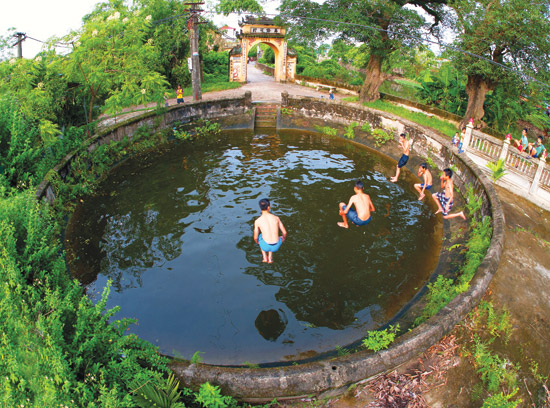(No.10, Vol.4,Nov-Dec 2014 Vietnam Heritage Magazine)
A well in Khuc Thuy Town, Hanoi
To most of the countryside, the well is the source of life. Each household may have their own well, but each village has also at least one common village well. Village girls come there daily to get water, enjoy their reflection and display themselves for village boys. These latter encounters often become dates that take place at the same well. The well is often the social centre of the village, the place where information is exchanged.
In recent decades, Vietnamese villages have been modernized. Many families have big tanks to store rain water for year-round use. Many ancient suburban villages even have tap water. Well water has fallen out of fashion. Many village wells are filled to make ground for construction. But here and there, the village well is still a source of clean water and a part of people’s lives, still the convergence point of life and happiness.
Dai Phung Communal well in Dan Phuong district of Hanoi is a borehole in a mass of laterite, lined inside with laterite bricks for a simplistic effect.
But Thap Temple well in Bac Ninh Province, located right in front of the ancestry altar, is also a borehole in a blue limestone mass, carved quite delicately to look like a blossoming lotus on a flat base. Vietnam Art Museum made a partial duplicate of it to put on show in its garden, so people from all over the world can see a feature of the Vietnamese countryside.
At the Upper Edifice of Tao Temple Linh Tien, Cao Xa Village, Hoai Duc District of Hanoi, there is a well that the people around believe to be a sacred red sand spring, an infinite source of clear sweet water. They use this water in all religious rituals.
At Ke Nguom, Nghiem Xuan Commune, Thuong Tin District of Hanoi, there is a big well near Nhue River, named Khoai. No matter if the land is in drought or flooded, the water in it is always pure, sweet and at a stable level. Khoai is the pride of the region. Brewed in this water, tea is exceptionally aromatic and deeply sweet.
At Dau pagoda, Bac Ninh Province, there is a well without mouth. Legends have it that this is where Lady Man thrust Kaudinya’s staff to open a spring during a drought. The well is always full of pure water for the pagoda’s needs. Also in Bac Ninh Province, Phat Tich Pagoda has in its premises the remains of three ancient wells from the Ly era, the time when the pagoda was established. One is on the hill slope behind the pagoda, with stone steps leading to the water. One is in the front courtyard, with a stone dragon head from where pure cool water gushes perpetually. And late last century, at the bottom of the pagoda’s pond, a well was found with some ceramic decoration items which used to be popular in ancient architecture.
At Pho Minh pagoda in Nam Dinh Province, the two wells in the front are believed to be dragon eyes. There is another one behind the pagoda, lined inside with pots full of lime. That’s why the water in it is so clean and clear.
Next to Saint Edifice in Keo pagoda, Thai Binh Province, ancient people used pierced stone mortars to build a well. The stones cleansed the water and kept the well strong through ages.
At Duong Lam of Son Tay township there is a small well, over a thousand years old, just a little wider than a palm hat’s rim, full and limpid. It is called the Milk Well. Legends say that mothers with dry breasts can come here to pray and drink the water from the well, and their breasts will be full of milk afterward. Duong Lam mothers still do it today.

A well at Thay Pagoda, Quoc Oai
District, Hanoi

A well in Tien Phuong
Commune, Chuong My District, Hanoi

A well at Tram Gian Pagoda,
Chuong My District, Hanoi

